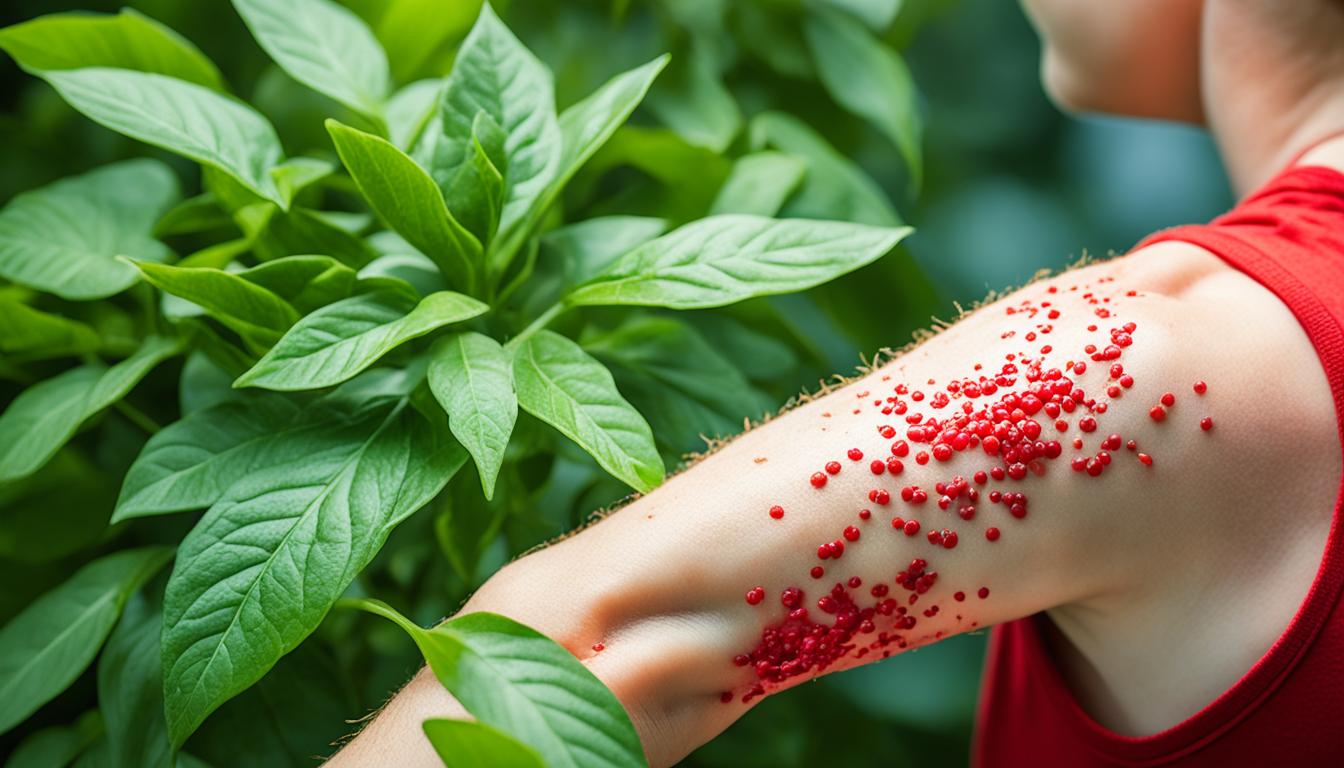Poison ivy is a plant that can cause a really itchy rash. It’s a shrub or vine with bright green leaves. These leaves turn red in the fall. The plant oil, called urushiol, is what makes the skin react. You can get the rash by touching the plant or from things that touched the plant.
If you touch poison ivy, you might see a rash soon. The skin will become red, swollen, and very itchy. The rash can be thick or in thin lines. Sometimes blisters will show up. They can leak a clear to yellow liquid and then crust over. You can use creams, steroids, or antihistamines to treat it. But, stem cell therapy can be a more advanced treatment.
Key Takeaways:
- Poison ivy can cause an itchy and uncomfortable rash on the skin.
- Exposure to the plant oil, urushiol, leads to the development of the rash.
- Symptoms of a poison ivy rash include redness, swelling, and intense itching.
- Treatment options range from creams and steroids to antihistamines.
- Stem cell therapy offers a potentially effective approach to relieving poison ivy rash symptoms.
Identifying and Preventing Poison Ivy Rash
Poison ivy is a common plant that causes an itchy rash on the skin. To avoid this, learning to spot the plant is key. Knowing how to handle it safely helps prevent the rash.
Identifying Poison Ivy
Look for poison ivy with three bright green leaves and a red stem. Its leaves might be smooth or have edges like a saw. It can be a vine or a shrub. Learn to identify it to steer clear.
Preventing Poison Ivy Rash
There are key steps to keep poison ivy rash at bay:
- Wear clothing that covers your skin, like long pants and long-sleeved shirts, when outdoors.
- Use a lotion with zinc oxide or titanium dioxide to block poison ivy oil.
- Never touch the plant directly.
- Look out for poison ivy in your surroundings and stay away from it.
Preventing the Spread of Poison Ivy Rash
It’s also important not to spread the rash. Here’s how to avoid making it worse:
- Wash clothes and shoes that might have poison ivy oil on them in hot water and detergent.
- Clean tools and outdoor gear regularly to remove any leftover oil.
- Be careful with plants that look like poison ivy, as they can cause the same rash.
If you think you’ve touched poison ivy, act fast:
- Use soap and cool water to wash your skin within a few minutes of exposure. Don’t forget to clean under your nails.
- Don’t scratch the rash, to avoid making it worse or getting an infection.
- Creams with calamine or hydrocortisone can help with the itch and swelling.
- If the rash doesn’t go away, see a doctor for more help.
Treating and Managing Poison Ivy Rash
Dealing with a poison ivy rash includes many options for relief. Poison ivy rash treatment often means using special creams. These help reduce itching and swelling. For more serious cases, doctors might give you steroids. You can take them as pills or use them in cream form. These make symptoms better. Also, you can use antihistamines to help with itching and sleep issues.
To manage the rash, keep it clean and dry. It’s best not to scratch it. This can stop an infection from starting. You might also try putting on cool things or using cornstarch or oatmeal in your bath. These steps can help the rash feel better quicker.
There are many poison ivy rash home remedies too. Calamine lotion and hydrocortisone cream can make the itching go away. Warm oatmeal baths or soaking in aluminum acetate can also calm your skin.
If the rash is very bad or spreading fast, see a doctor. This is especially true if it’s on your face, private areas, or you think it’s infected. Don’t wait to get help if you feel very sick, or have trouble breathing. Also, get medical care if you were near burning poison ivy and then got a rash.

